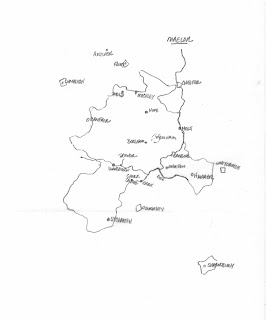The small town (village) of Trefor (Trevor) is located about 1.5 miles east of the hill fort Dinas Bran. It is nestled in Vale of the Dee, on the north side, just down river from Llangollen. [See p. 112, A Gazetteer of Welsh Place-Names, #33/2642.] It is here that Welsh genealogist identify the location of the birth of the "Founder of The Tribe of The Marches", Tudor... thus, Tudor of Trefor, or Tudor Trevor (Tydyr Trefor). It is a fairly uncommon Welsh naming that identifies a child with his place of birth. There must have been some significance to this location, since its identity is forever attached to this individual.
The figure to the right tries to place the River Dee in relationship to both Maelors, since in Burke, Tudor Trevor is identified as "Lord of Both Maelors". The Dee seems to split this area, with what was to become "Welsh Maelor" to the northwest, and "English Maelor" to the southeast. The town of Wrexham becomes central to the Welsh side, and the town of Overton to the English side.
The second drawing shows the approximate location of the village of Trefor. The Viking raids had begun along the north coast of Wales, and it is possible that these "Black Gentiles" had caused the small village of Trefor to become a hideout. The geographic relationship to Oswestry, Hanmer, Bangor, Chirk, Bersham, and Llanfair, are also shown. In time, these additional towns and villages will all become part of the "Tribe of The Marches"...starting from the tiny town of Trefor!


